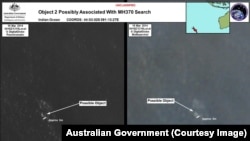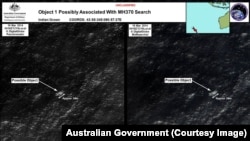BANGKOK —
The apparent breakthrough in the 12-day search for the Malaysia Airlines’ flight MH370 came Thursday when Australian authorities said satellite imagery has located unidentified debris some 2,500 kilometers southwest of Perth, in the Indian Ocean, that could be from the missing airliner. Australia is sending search planes and ships to the region to try to confirm the finding.
Australian Prime Minister Tony Abbott told the Australian parliament "new and credible" information had come to light in the search for the Malaysian Boeing 777 that disappeared on March 9 bound for Beijing with 239 passengers and
crew.
"The Australian maritime safety authority has received information based on satellite imagery of objects possibly related to the search. Following analysis of this satellite imagery two possible objects related to the search have been identified," said Abbott.
Abbott told Parliament a Royal Australian Air Force Orion aircraft had been diverted in an attempt to locate other objects.
In a news conference a short while later, John Young, the general manager of Australia's maritime authority, said the larger of the objects is roughly 24 meters wide.
“The objects are relatively indistinct on the imagery. I don't profess to be an expert in assessing the imagery. But those who are expert indicate they are credible sightings. The indication to me is of objects that are a reasonable size and probably awash with water bobbing up and down under the surface,” said Young.
Young said the satellite imagery is not clear enough to determine if there are markings or features that would confirm if they are from the missing passenger jet. The objects were spotted in a part of the ocean that authorities estimate is several thousand meters deep.
Authorities are scrambling four search aircraft from Australia, New Zealand and the United States that have maritime radar appropriate for locating the objects spotted by the satellites.
Although the weather in the area is moderate, officials say visibility is not ideal, which could hamper search efforts. Authorities are also sending a C130 Hercules plane that will drop data marker buoys to track water currents and trace where the debris could be moving.
Young was cautious not to raise expectations until the findings can be confirmed.
“We have been in this business of doing search and rescue and using satellite images before and they do not always turn out to be related to the search even if they look good. So we will hold our views on that until they have been sighted close up,” said Young.
Authorities were noncommittal about when that confirmation could come, but said the first of the four search planes are already on the scene and others are expected to arrive in the coming hours. More than 25 countries have been involved in the search for the missing aircraft.
Australian Prime Minister Tony Abbott told the Australian parliament "new and credible" information had come to light in the search for the Malaysian Boeing 777 that disappeared on March 9 bound for Beijing with 239 passengers and
crew.
"The Australian maritime safety authority has received information based on satellite imagery of objects possibly related to the search. Following analysis of this satellite imagery two possible objects related to the search have been identified," said Abbott.
Abbott told Parliament a Royal Australian Air Force Orion aircraft had been diverted in an attempt to locate other objects.
In a news conference a short while later, John Young, the general manager of Australia's maritime authority, said the larger of the objects is roughly 24 meters wide.
“The objects are relatively indistinct on the imagery. I don't profess to be an expert in assessing the imagery. But those who are expert indicate they are credible sightings. The indication to me is of objects that are a reasonable size and probably awash with water bobbing up and down under the surface,” said Young.
Young said the satellite imagery is not clear enough to determine if there are markings or features that would confirm if they are from the missing passenger jet. The objects were spotted in a part of the ocean that authorities estimate is several thousand meters deep.
Authorities are scrambling four search aircraft from Australia, New Zealand and the United States that have maritime radar appropriate for locating the objects spotted by the satellites.
Although the weather in the area is moderate, officials say visibility is not ideal, which could hamper search efforts. Authorities are also sending a C130 Hercules plane that will drop data marker buoys to track water currents and trace where the debris could be moving.
Young was cautious not to raise expectations until the findings can be confirmed.
“We have been in this business of doing search and rescue and using satellite images before and they do not always turn out to be related to the search even if they look good. So we will hold our views on that until they have been sighted close up,” said Young.
Authorities were noncommittal about when that confirmation could come, but said the first of the four search planes are already on the scene and others are expected to arrive in the coming hours. More than 25 countries have been involved in the search for the missing aircraft.









